This discussion and review contains spoilers for Star Trek: Strange New Worlds season 2, episode 5, “Charades,” on Paramount+.
“Charades” arrives as the fifth episode of the second season of Strange New Worlds, in the exact same space that “Spock Amok” occupied during the show’s first season. It’s interesting that Strange New Worlds has already fallen into this sort of routine, with the midpoint of a given season devoted to a broad comedy episode based around some bodily mishap for Lieutenant Spock (Ethan Peck).
In “Charades,” Spock is effectively made human by omnipotent aliens seeking to make “remediation” after a shuttle accident on the Vulcan moon of Kerkhov. As with so many Strange New World plots, this is something that the Star Trek franchise has done quite regularly. B’Elanna Torres (Roxann Dawson) was split into her human and Klingon halves in “Faces.” Odo (René Auberjonois) was exiled from the Great Link and forced to spend half a season as a human in “Broken Link.”
There is a recurring sense that the conflict between the two halves of Spock’s psyche, human and Vulcan, is well-trodden ground at this point in the franchise, explored by both Leonard Nimoy and Zachary Quinto. It’s revealing that “Charades” is the episode of Strange New Worlds most focused on Christine Chapel (Jess Bush) to date, and she has to content herself with a subplot like the one that Erica Ortegas (Melissa Navia) got in “Among the Lotus Eaters.”
Still, there is a lot to like about “Charades.” As with “Spock Amok,” it benefits from pitching itself as a Star Trek comedy episode, which means that it invites comparisons to some of the franchise’s more disposable episodes like “Rascals” or “Body and Soul.” This isn’t “A Quality of Mercy” riffing on two of the greatest episodes of television ever, “The City on the Edge of Forever” and “Balance of Terror.” This is Strange New Worlds doing a competent imitation of an uneven subgenre.
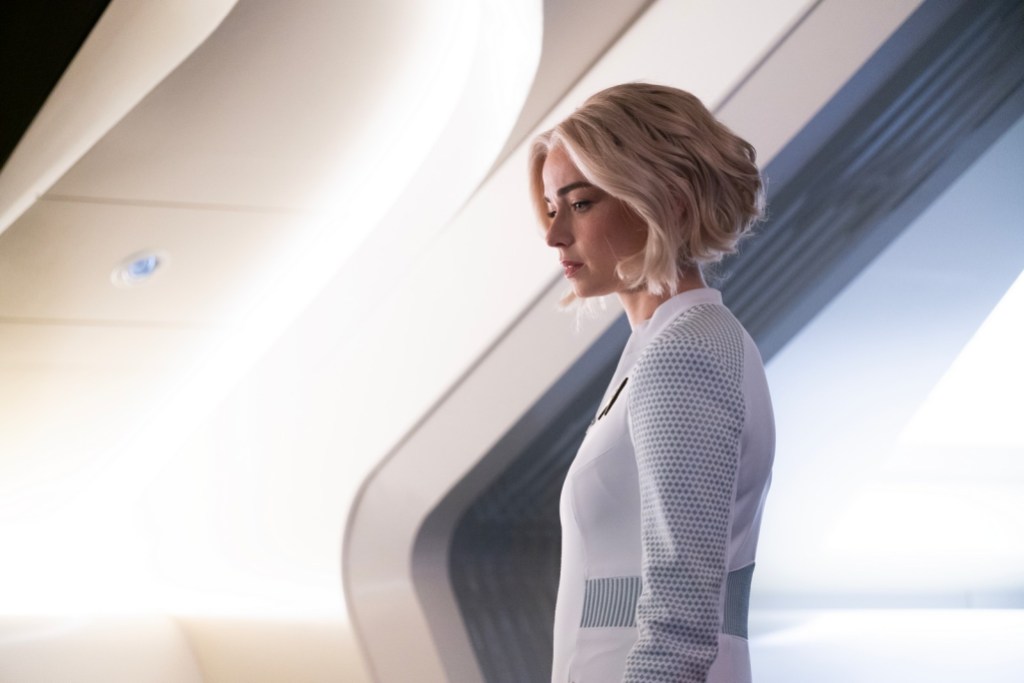
More than that, it allows Strange New Worlds to lean further into its approach to Spock as a fundamentally queer character. This is not a new approach to Spock, who has had a strong queer fandom since the earliest days of Star Trek and was one half of the homoerotic couple that invented “slash” fiction. This is part of the reason why so many in the queer community were thrilled to see the character played by Zachary Quinto, an openly gay actor, in the J.J. Abrams Star Trek films.
To its credit, Strange New Worlds has made a conscious effort to embrace this side of Star Trek. The show has made a point to cast transgender and nonbinary performers like Jesse James Keitel and Noah Lamanna. “Ad Astra Per Aspera” was the best live-action episode of Star Trek in years because it grappled with the franchise’s historical failures in this particular area. Arguably, even the addition of “great ally” Carol Kane to the supporting cast of the second season plays into this.
This may also explain why Strange New Worlds is so obsessed with Spock’s body and biology. Early Star Trek shows seemed more preoccupied with Spock’s soul or his mind — his “katra.” Spock’s consciousness was often separated from his body in stories like “Spock’s Brain” or Star Trek III: The Search for Spock, but there was always a sense that Spock’s body was perfect for his brain; he just had to find his way back to it by reconciling his human and Vulcan halves.
In contrast, Strange New Worlds makes a point to repeatedly place Spock’s mind in a body that doesn’t belong to him and that is fundamentally alien. There is a big difference between Spock putting his katra into McCoy (DeForest Kelley) at the end of Star Trek II: The Wrath of Khan and the body swap with T’Pring in “Spock Amok,” just as there’s a difference between Spock’s brain being removed from his body in “Spock’s Brain” and having his body transformed in “Charades.”
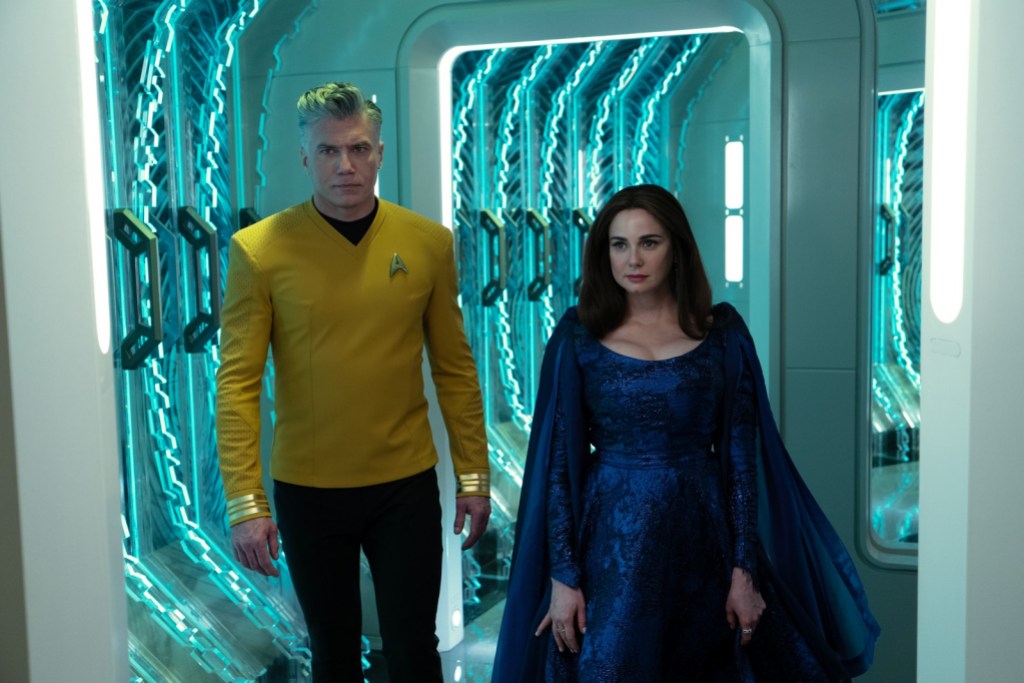
As with the emphasis on Una Chin-Riley’s (Rebecca Romijn) genetic modifications in “Ad Astra Per Aspera,” there is a sense that Strange New Worlds is fascinated by the shifting understanding of the self’s relationship to the body, the idea that the body that a person is born into may not be their fullest expression of self. It is a commendable and laudable approach to the material, and Strange New Worlds should be doing it more often, updating these tropes for the modern world.
Strange New Worlds hasn’t always handled this sort of subtext particularly well, with “The Serene Squall” stumbling somewhat clumsily into some reactionary subtext. Still, the show’s heart is undeniably in the right place, and “Charades” is best understood as an exploration of Spock’s queerness that emphasizes the performativity involved. With his “ceremonial engagement dinner” looming, this newly human Spock is forced to pretend to be Vulcan, putting on a pantomime for an audience.
Philosopher Judith Butler famously contended that “gender reality is performative which means, quite simply, that it is real only to the extent that it is performed.” People often play “roles” assigned to them in these social structures and are judged by how they conform to the expectations that come with those roles. Even more than the party game suggested by Christopher Pike (Anson Mount), these are the “charades” at the heart of the episode.
Spock spends most of “Charades” pretending to be something that he is not, within the rigid confines of the heavily ritualized engagement dinner. It’s very pointed that this is a performance of heteronormativity, that Spock must present himself as a viable husband to T’Pring (Gia Sandhu) for the benefit of her family. To do so, Spock must not only conceal his true identity but also suppress his true emotions. It is not an especially subtle metaphor, but that is okay — Star Trek has never been especially subtle.
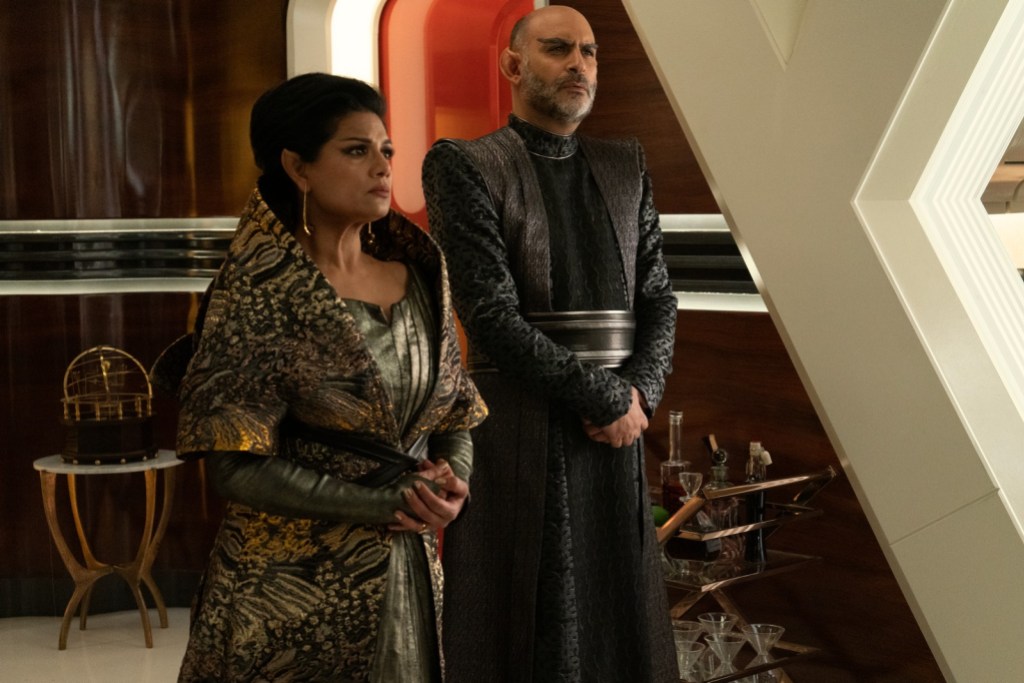
That said, there is a sense in which “Charades” uses this framing to indulge in some rather cliché jokes about old-fashioned gender roles that feel lifted directly from a 1950s sitcom. When she arrives on the Enterprise, T’Pring talks to Spock about how long it took her to find the right thing to wear. Repeatedly, T’Pring’s father (Michael Benyaer) is presented as a henpecked husband, under the thumb of his wife T’Pril (Ellora Patnaik).
It is possible to read these jokes as commentary on the stereotypical norms of traditional heteronormative relationships, but it also feels like Strange New Worlds is trying to have things both ways — to acknowledge the sexism of the joke while still making the joke. That said, the episode’s broad comedy works reasonably well. In particular, “Charades” makes great use of Anson Mount, frequently cutting to Pike for deadpan reaction shots or letting him play in the background of scenes.
Of course, “Charades” inevitably runs into the same sorts of problems that routinely affect even the stronger episodes of Strange New Worlds. As with “Among the Lotus Eaters,” “Charades” is a reminder that it is impossible to do justice to a cast this size within an episodic framework with only 10 episodes in a season. So, as with Ortegas before her, Chapel is consigned to a single character-focused subplot, rather than being given her own character-driven episode.
It doesn’t help that Chapel is basically given the same arc as Ortegas, learning to be happy where she is and not to want anything more than what she already has. She shouldn’t leave the Enterprise to study archaeological medicine; she should stay there forever. It’s also frustrating that Chapel’s biggest arc in “Charades” isn’t anything she does, but a shift in how Spock sees her, prompted by Amanda’s (Mia Kirshner) observation that “it is not easy being a human who loves a Vulcan.”
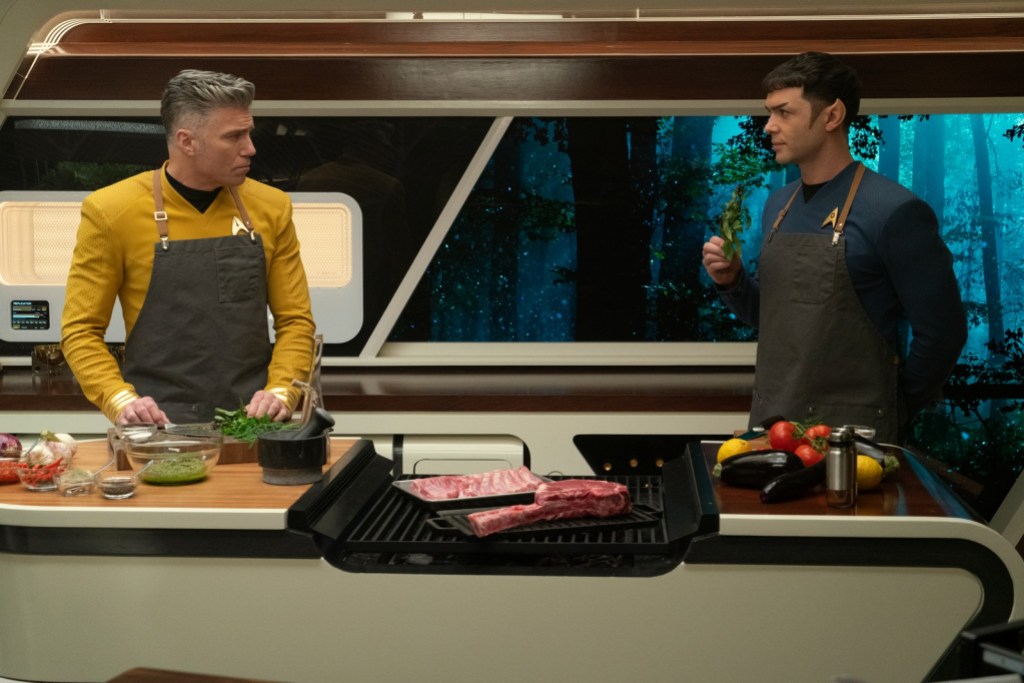
Indeed, “Charades” also embodies some of the worst impulses of Strange New Worlds. The episode’s preoccupation with performativity ties into the show’s tendency to spend a lot of time performing Star Trek rather than just being Star Trek. Throughout Strange New Worlds, characters will frequently draw attention to the tropes and conventions of Star Trek as they employ them, as a way of asserting that Strange New Worlds must be Star Trek because it does the things Star Trek does.
In “Charades,” Spock essentially has to learn how to play a Vulcan. Joseph M’Benga (Babs Olusanmokun) even makes him a set of prosthetic ears to underscore the point. “We couldn’t do it genetically, as it might affect the care Ms. Chapel has rendered,” M’Benga explains when he presents his patient with the props. “So we made these instead.” It’s very self-aware, to the point that Spock gets lessons on “how to speak like a Vulcan” from Nyota Uhura (Celia Rose Gooding), recalling the discussion of his “thing” in “The Broken Circle.”
It’s like an acting class, with Spock learning to take direction. “Flatter, more robotic,” La’an Noonien-Singh (Christina Chong) instructs him. Ortegas adds, “Notice how I move my eyebrow, but no other muscle in my face.” Later, Pike offers some advice on best practice when faking a mind meld, “Don’t grit your teeth like that. Try maybe pretending you’re seeing something, like memories.” Spock protests, “I don’t know how to fake it.” To quote Laurence Olivier, maybe “just try acting.”
To be fair, it is tough to play a Vulcan. Only a handful of actors have pulled it off convincingly over the course of the franchise: Leonard Nimoy, Mark Lenard, Tim Russ, Gary Graham, Zachary Quinto. “It’s the opposite of what I’ve trained for, but on the other hand it’s a challenge to try to allow the slightest, most subtle emotions,” Russ has explained. “One of my acting partners said Tuvok is the character who can play Hamlet with his eyebrow.” It is a difficult assignment.
However, as with so much of Strange New Worlds, there’s a sense that it would be more engaging to watch Ethan Peck actually do that than it is to listen to characters discuss the mechanics of it at length. Roman emperor Marcus Aurelius famously argued, “Waste no more time arguing what a good man should be. Be one.” Maybe Strange New Worlds should waste no more time arguing what Star Trek should be, and just be it.

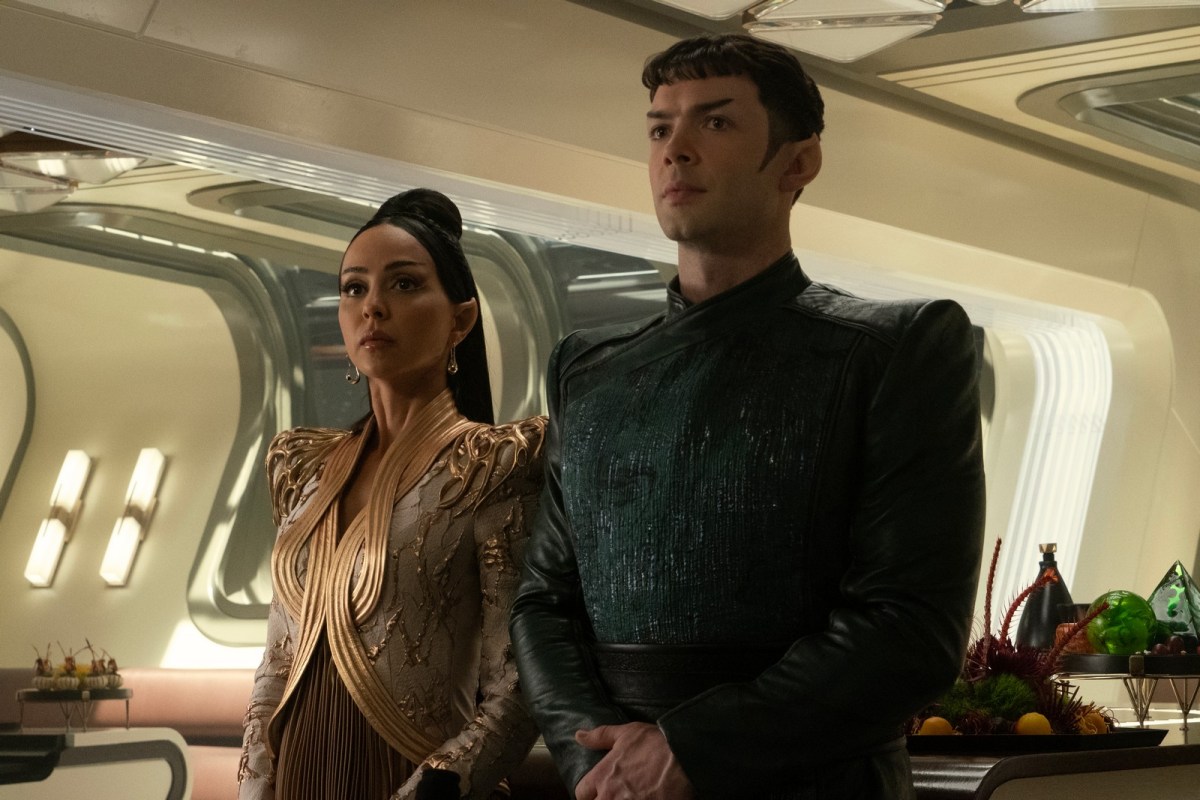




Published: Jul 13, 2023 10:00 am